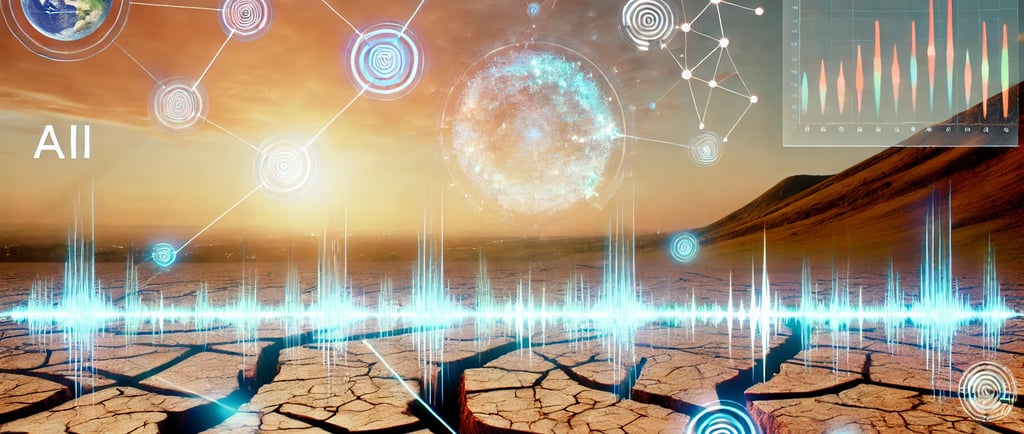How AI is Helping Earthquake Prediction: Insights from Recent Research
8/30/20247 min read


Introduction: The Growing Role of AI in Earthquake Prediction
Earthquake prediction has long been a critical area of research with the potential to save countless lives and mitigate extensive property damage. Traditional methods, primarily seismology-based approaches, have relied on analyzing historical data, geological surveys, and fault line monitoring. Despite their contributions, these methods are often limited by their inability to provide accurate, timely predictions, resulting in unforeseen natural disasters that catch communities unprepared.
Artificial intelligence (AI) is rapidly emerging as a transformative technology that promises to overcome many of the limitations of conventional earthquake prediction methods. By leveraging vast amounts of real-time data, sophisticated algorithms, and advanced machine learning techniques, AI can analyze complex patterns and anomalies that would be difficult for humans to detect. This capacity for large-scale, high-speed data processing is not only enhancing the accuracy of earthquake predictions but also reducing the time required to make these crucial forecasts.
The urgency for improved earthquake prediction cannot be overstated. As urban populations grow and infrastructure becomes more intricate, the potential devastation of unpredictable seismic events is magnified. Early detection and precise warning systems powered by AI offer the possibility of timely evacuations, better emergency response strategies, and stronger construction standards, thereby significantly reducing the impact of earthquakes.
In this evolving landscape, recent research underscores the increasing role that AI will play in advancing our understanding of seismic activities. As we delve further into how AI is reshaping earthquake prediction, it becomes evident that this technology is not merely an enhancement but a necessity for future resilience against natural calamities. The integration of AI into earthquake prediction systems marks a critical step forward in safeguarding communities and minimizing the consequences of these unpredictable natural events.
The Mechanics of Earthquakes: Why Prediction is Complex
Earthquakes are natural events resulting from the sudden release of energy in the Earth's crust, generating seismic waves that can cause extensive damage. This intricate phenomenon is primarily driven by the movement of tectonic plates, the enormous slabs that make up the Earth's surface. The boundaries where these plates meet, known as fault lines, are particularly susceptible to stress accumulation. When the stress surpasses the strength of the rocks, it is released in the form of an earthquake.
One of the main complexities in predicting earthquakes lies in the immense variability of seismic activity. Tectonic plates move at rates of just a few centimeters per year, but the stress can accumulate over centuries before a major earthquake occurs. This irregularity, coupled with the movement of faults that can be tens to hundreds of kilometers long, makes it challenging to pinpoint when and where an earthquake will strike.
Seismic waves, which propagate from the earthquake’s focus, add another layer of complexity. There are multiple types of seismic waves, each traveling at different speeds and exhibiting different behaviors. Primary waves (P-waves) are the fastest, followed by Secondary waves (S-waves). The slower surface waves cause the most damage. Understanding the behavior of these waves is essential for earthquake prediction, yet their interaction with the Earth's heterogeneous interior complicates this task.
Current earthquake prediction models are limited by several factors, including the incomplete understanding of fault mechanics, the lack of comprehensive real-time data, and the challenges in simulating the Earth's intricate geological structures. Despite advancements in seismology, the existing methods can only estimate probabilities and potential magnitudes rather than providing precise forecasts.
Hence, the unpredictability of earthquakes poses significant hurdles for traditional prediction approaches, creating an acute need for innovative solutions. With recent technological advancements, artificial intelligence (AI) emerges as a promising avenue to enhance our predictive capabilities. However, leveraging AI requires overcoming the existing challenges and limitations inherent to the complex nature of earthquakes.
AI Technologies Transforming Earthquake Prediction
In the rapidly evolving field of seismology, artificial intelligence (AI) is emerging as a transformative force, enhancing our ability to predict earthquakes with increased accuracy. Key AI technologies, such as machine learning algorithms, neural networks, and advanced data analytics, are at the forefront of this seismic shift. By leveraging vast datasets obtained from seismic sensors, geological surveys, and historical earthquake records, these technologies offer unprecedented insights into earthquake prediction.
Machine learning algorithms, for instance, are adept at recognizing complex patterns within enormous amounts of data. Recent research highlights their effectiveness in analyzing seismic waves and identifying precursors to earthquakes. A notable study published in "Nature Communications" utilized a neural network model trained on millions of seismic events, enabling the prediction of earthquake occurrences with remarkable precision. The model's ability to process data in real-time and adapt to new information showcases the potential of AI-powered methodologies.
Neural networks, particularly deep learning models, have significantly advanced earthquake prediction capabilities. These systems can process intricate layers of data, extracting meaningful patterns that might otherwise elude traditional analysis methods. An interdisciplinary project spearheaded by researchers at Stanford University demonstrated the use of convolutional neural networks (CNNs) to identify foreshocks and anticipate subsequent larger seismic events. The CNNs processed data from previous tremors, yielding promising results that indicate a way forward for AI-assisted earthquake prediction.
Data analytics is integral to comprehensively understanding seismic activity. AI technologies excel in managing and interpreting vast datasets, enabling the integration of diverse data sources, including geological surveys and historical records. The University of Tokyo's recent breakthrough involved combining AI algorithms with big data analytics to map high-risk seismic zones more accurately. This innovative approach not only enhances prediction accuracy but also aids in resource allocation for disaster preparedness and response.
Ongoing projects continue to push the boundaries of AI in earthquake prediction. Collaborations between tech companies, academic institutions, and government agencies are fostering an environment where AI technologies can be refined and applied on a broader scale. As these technologies evolve, they promise to offer safer, more alert-ready societies through timely and precise seismic predictions.
Case Study: Recent Research Breakthroughs in AI for Earthquake Prediction
Recent strides in earthquake prediction have been realized through the collaborative efforts of seismologists and data scientists leveraging artificial intelligence (AI). A notable study from Stanford University has made significant progress in this domain. The primary objective of the research was to enhance the accuracy and reliability of earthquake predictions utilizing machine learning techniques.
The methodology entailed the collection and analysis of vast quantities of seismic data from various geographical regions prone to seismic activity. The researchers implemented sophisticated machine learning algorithms, such as neural networks, to identify patterns that conventional methods might overlook. These patterns were used to predict potential earthquake occurrences, their magnitude, and probable impact zones.
The findings of this groundbreaking study were promising. The AI models developed during the research demonstrated a superior ability to detect subtle shifts and anomalies within seismic data, which often precede an earthquake. Such advancements considerably minimized the false alarm rates that have historically plagued earthquake prediction efforts. With this enhanced precision, early warning systems can provide more accurate and timely alerts, potentially saving countless lives and mitigating economic loss.
Moreover, the implications of this research extend beyond just the scientific community. The improved predictive capability allows for more effective disaster preparedness and response strategies. Communities in earthquake-prone regions can benefit from targeted risk mitigation initiatives, customized to the newly available predictive analytics. Insurance and real estate sectors can also utilize these insights to assess risks more accurately, ensuring better resource allocation.
The interdisciplinary collaboration between seismologists and data scientists has been instrumental in achieving these breakthroughs. By combining the domain expertise of seismologists with the advanced analytical skills of data scientists, the team could push the boundaries of what is possible in earthquake prediction. This partnership exemplifies the potential of AI to revolutionize our understanding and management of natural disasters.
The Impact of Early Earthquake Prediction: Saving Lives and Reducing Damage
Early earthquake prediction has the potential to make a significant impact on society, particularly in terms of saving lives and minimizing damage to infrastructure. Timely alerts can be the difference between chaos and well-coordinated evacuation efforts, allowing communities to react promptly and effectively. When predictions are made early enough, authorities can implement evacuation plans, which can drastically reduce the number of casualties. Additionally, infrastructures can be temporarily fortified or evacuated if needed, lessening the risk of structural failures that could lead to widespread devastation.
For instance, recent case studies have shown that in regions with early earthquake warning systems, casualties and damage have been markedly lower. In Japan, where advanced earthquake prediction models are in place, an early warning issued mere seconds before the 2011 Tōhoku earthquake gave people a crucial head start to take protective actions. Although it was an immensely destructive event, the early alert undoubtedly saved a significant number of lives. Similarly, in Mexico City, early earthquake warning systems have prompted the modification of building codes, leading to more resilient infrastructure that is better equipped to withstand seismic activities.
Moreover, the societal benefits of early prediction extend to public awareness. Prepared citizens are more likely to respond efficiently in emergencies, and ongoing public education efforts can help instill a culture of preparedness. By leveraging AI-powered models that analyze seismic data and predict potential earthquakes, we move closer to achieving the 'AI for Good' objective. The integration of artificial intelligence in this realm is proving to be a game-changer, offering enhanced accuracy and timeliness in predictions.
The statistical data lends substantial credibility to the effectiveness of early prediction systems. According to the United States Geological Survey (USGS), a well-executed early warning system in California could potentially reduce fatalities by up to 50% in a substantial earthquake event. Such figures underscore the immense promise that early earthquake prediction holds for not only saving lives but also ensuring that society is better prepared and more resilient in the face of natural disasters.
Future Directions: Enhancing AI Models and Broadening Applications
As we look toward the future of AI in earthquake prediction, it is clear that significant advancements are on the horizon. One crucial area requiring attention is the development of more comprehensive datasets. Current models often rely on historical seismic data, which can be fragmented and inconsistent across different regions. Integrating real-time data from various global sensors, incorporating geological, atmospheric, and even oceanic indicators, can substantially enhance the accuracy of AI algorithms. This holistic approach necessitates robust data-sharing mechanisms and collaboration among international scientific communities.
Another critical challenge lies in the integration of multi-disciplinary approaches. Conventional earthquake prediction relies heavily on geophysical data. However, incorporating insights from disciplines such as geology, hydrology, and even animal behavior could unearth new patterns and precursors to seismic events. Cross-disciplinary research can foster innovative methodologies, leading to breakthroughs in predictive accuracy.
The advent of emerging technologies, particularly quantum computing, holds significant promise for advancing AI capabilities in earthquake prediction. Quantum computing can process complex calculations at unprecedented speeds, allowing for the creation of more sophisticated predictive models. These models could analyze vast datasets in real-time, delivering predictions with higher precision and confidence.
Beyond earthquake prediction, the improvements in AI can be extended to other natural disaster forecasts, broadening support for AI for Good initiatives. Floods, hurricanes, and volcanic eruptions are some areas where enhanced predictive models could save lives and mitigate economic losses. Leveraging AI's potential across multiple disaster types underscores the broader impact that these technological advancements could achieve. By embracing a multi-faceted approach to AI development, the field can continue to make strides, not just in predicting earthquakes, but in safeguarding communities against a spectrum of natural disasters.
